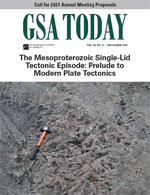Abstract View
Volume 30 Issue 12
(December 2020)
GSA Today
Article, pp. 4-10 | Full
Text |
PDF
The Mesoproterozoic Single-Lid Tectonic Episode: Prelude to Modern Plate Tectonics
Robert J. Stern
Geosciences Dept., The University of Texas at Dallas, Box 830688, Richardson, Texas 75083-0688,
USA
Abstract
The hypothesis that the Mesoproterozoic (1600–1000 Ma) tectonic regime was a protracted
single-lid episode is explored. Single-lid tectonic regimes contrast with plate tectonics
because the silicate planet or moon is encased in a single lithospheric shell, not a global
plate mosaic. Single-lid tectonics dominate among the Solar System’s active silicate bodies, and
these show a wide range of magmatic and tectonic styles, including heat pipe (Io), vigorous
(Venus), and sluggish (Mars). Both positive and negative evidence is used to evaluate the
viability of the Mesoproterozoic single-lid hypothesis. Four lines of positive evidence are: (1)
elevated thermal regime; (2, 3) abundance of unusual dry magmas such as A-type granites and
anorthosites; and (4) paucity of new passive continental margins. Negative evidence is the lack
of rock and mineral assemblages formed by plate-tectonic processes such as ophiolites,
blueschists, and ultra high-pressure terranes. Younger plate-tectonic–related and
Mesoproterozoic mineralization styles contrast greatly. Paleomagnetic evidence is equivocal but
is permissive that Mesoproterozoic apparent polar wander paths of continental blocks did not
differ significantly. These tests compel the conclusion that the Mesoproterozoic single-lid
hypothesis is viable.
Manuscript received 12 Aug. 2020. Revised manuscript received 10 Sept. 2020.
Manuscript accepted 15 Sept. 2020. Posted 29 Sept. 2020.
© The Geological Society of America, 2020. CC-BY-NC.
https://doi.org/10.1130/GSATG480A.1
Cover Image

Search Google Scholar for
Search GSA Today
